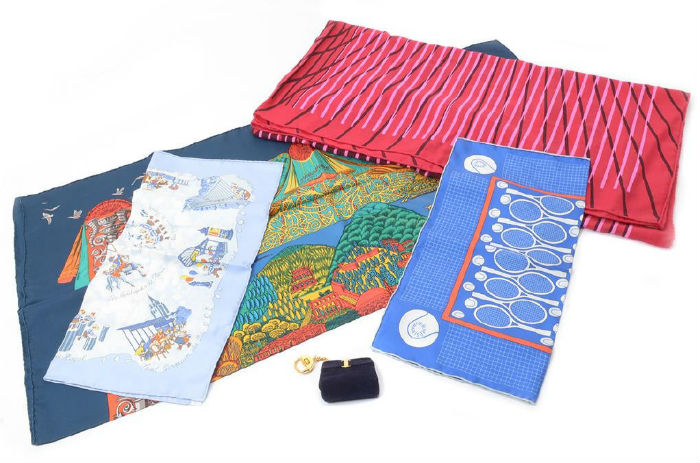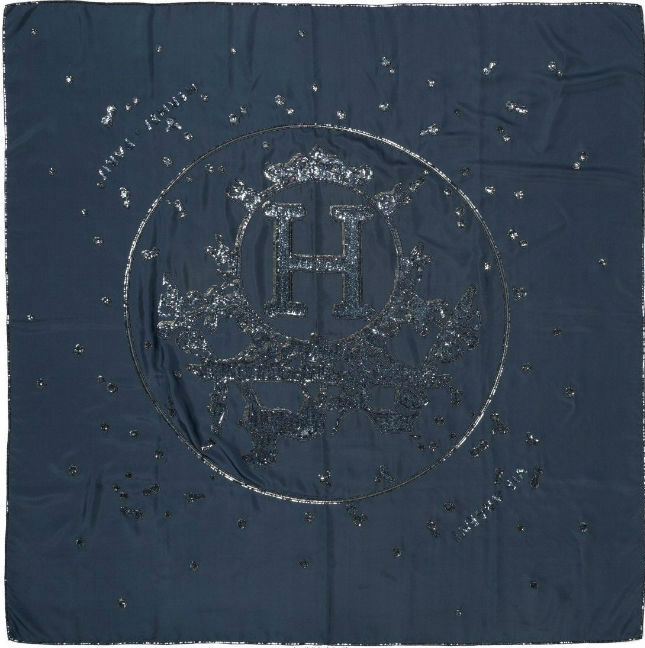
NEW YORK – Since creating its first silk in 1937, Jeu des Omnibus et Dames blanches, depicting women playing a board game within a border of horse-drawn buses, Hermes has dominated the luxury fashion accessories market. Owing to their shape, the firm’s iconic silk scarves are often called a “carré” for the French word for square.
They are a staple in any well-dressed closet, looking elegant with chic clothing or to dress up a black T-shirt and jeans. One does not merely wear an Hermes scarf but is transformed by one. New scarves will retail for over $400 and vintage examples, especially rare designs, are highly collectible and sell well on secondary and auction markets.
Hermes launched its business in 1837 initially crafting harnesses and saddles for horses, later expanding into luxury goods. Well known for handbags, Hermes is famous for its Kelly bag and leather Birkins. Its packaging is equally desirable, each item comes in its trademark bright orange box with scarves enveloped in a pillowy layer of tissue paper inside said box. Using silk cultivated from China, Hermes’ legion of artisans weave and silkscreen print each scarf at its factories in the Lyon area of France, said to be the birthplace of silk. Starting in the late 15th century, traders brought reams of silk to Lyon, kicking off a booming industry there that at its heyday saw nearly 30,000 silk workers in 1788. The silk-making tradition continues strong today.

According to Vintage Fashion Guide’s website, “Hermes scarf designs were produced from start to finish – they bought the raw silk from China, spun it into yarn, wove it into fabric, and screen-printed it.”
Some 2,000 unique silk scarf designs, most measuring 36 inches square (some are smaller at 17 and 24 inches square), have been made by Hermes by its artists over the years. In recent decades, an annual theme is chosen and about a dozen new designs representing that theme are created each year. Each scarf takes well over a year to make from the time the initial design is sketched until the tag is sewn onto the finished scarf. On average, the scarf will feature about a dozen to 20 different colors.

According to the Carre de Paris blog, the artist Philippe Ledoux made some of the most sought after scarves for Hermes, ranging from designs named “Cosmos” and “Napoleon” to “La Comedie Italienne.” Many of his designs had an equestrian motif befitting the company’s roots. “Like Hugo Grygkar, Philippe Ledoux, can be argued, has left a huge impact on the Maison Hermes, in particular, the Hermss carré,” a blog entry on the website says.
Grykar is said to be the most prolific designer for the firm, coming up with over 100 scarf designs with some of his early designs reissued time and again. Using 1850s artwork and books as inspiration for many of his scarves, Grykar is particularly known for his WWII-era scarves that used humor and whimsy to take people’s minds off the hard war years.

Among contemporary artisans who have designed scarves for Hermes is Annie Faivre. Starting in the late 1970s, she has created about 50 scarves for the fashion house, favoring an abstract style. Reportedly, in homage to a childhood nickname of “little monkey,” the artist has hidden a monkey into nearly all of her designs.
While horses and equestrian themes are frequently pictured on Hermes scarves, other motifs represented include boats, constellations, nature/botanical, mythology, tigers and other animals, travel, abstract and graphic patterns, politics and satire. Some scarves were even embellished with Swarovski crystals. The most popular designs have been reissued several times, including one of Hermes’ best loved, the “Brides de gala” scarf, which was a Hugo Grygkar creation. “One of Hermes’ most iconic scarves, this design has been reinvented endlessly since its creation in 1957,” according to the Hermes website.

Luxury goods are often counterfeited and while spotting fakes for new buyers can be challenging, there are certain things to look for on the real McCoy. An authentic Hermes scarf is made of double-ply Mulberry silk, never Jacquard silk. It will boast hand-finished edges, including a hand-rolled hem rolling toward the front (the side of the scarf with the most vivid hues) and the thread should match the scarf’s dominant color. Copyright tags are always in French or English.
Besides being colorful and artistic, Hermes scarves are versatile. They look great tied on the side of one’s neck but can also make an elegant headscarf. They can be worn around the waist or a sling as Grace Kelly famously did when nursing a broken arm. In addition to being wearable art, an Hermes scarf can also be framed and used as wall art.


